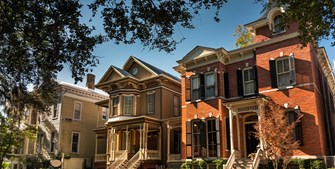Along with enjoying the architectural charm of a bygone era, owning a historic home means adding your own story to the decades and centuries of life within those walls. However, owning historic property comes with its own quirks, restrictions and requirements to preserve its charm, which often depend on government regulations. Read on to learn about the criteria for historic homes, tips for preservation, and resources to help offset the cost of renovations and repairs.
WHAT IS A HISTORIC HOME?
In the United States, all historic places—homes, buildings and sites—are designated and overseen by the National Park Service’s National Register of Historic Places (National Register), a federal list containing over 96,000 entries (as of 2020). States, cities and municipalities can also classify a home or district as historic.
Many cities go the extra mile to preserve entire neighborhoods as historic districts, such as Boston’s Beacon Hill, the French Quarter in New Orleans and San Francisco’s Jackson Square. If a geographic area has a noteworthy concentration of historically significant buildings or homes, it may be designated a historic district at the federal, state or local government level. Local designations are typically the most restrictive about what kinds of changes owners are allowed to make to the property. It’s best to check with your local government’s planning department for specific guidelines.
Though renovation and design options may be limited, historic districts tend to have steadier property values due to neighborhood associations’ support and commitment to preservation. By preserving historic residential neighborhoods and commercial districts, local governments reinvest in their communities, promote tourism and encourage civic pride.
CRITERIA FOR HISTORIC DESIGNATION
To qualify as a historic location on the National Register, a home must meet certain criteria in age, integrity and significance:
- It must be at least 50 years old.
- It must look the same as when it was first constructed.
- It must be connected to a historically significant person or event, such as:
- The home or birthplace of a prominent person or group.
- The source of important historical information about the local town or state.
- An example of historic architectural significance or the work of a prominent architect.
TIPS FOR PRESERVING A HISTORIC HOME
Once you’ve found your Federalist, Victorian, Craftsman or otherwise historically significant dream home, it’s in your best interest to research the historic rehabilitation regulations for the area, and prepare yourself and your budget for the necessary repairs and upkeep. Other tips to consider:
• Maintain a regular maintenance and inspection schedule. The architectural and exterior features that make your home historic may require particular cleaning, waxing and painting. Due to your home’s age, more frequent maintenance may be required to keep things in tip-top shape.
• Minimize repairs by addressing issues immediately. Many distinctive features like crown molding, columns, trims, floors, tile and windows require extra care in older homes. Avoid sanding wooden floors in order to maintain their longevity and hire a professional to replace or repair delicate plaster or masonry.
• Maintain architectural integrity when remodeling. You’ll be required to ensure that any renovations or additions match the existing style of the home’s design.
• Embrace the eccentric and unique details. Uneven floorboards, unusually shaped or stained-glass windows and unique fireplaces are all idiosyncrasies that make the home a treasure.
• Consult with the Secretary of the Interior’s Standards for Rehabilitation for further guidelines on repairs, alterations and additions.
FINANCIAL ASSISTANCE & INCENTIVES
Due to the civic value of historic homes, the government is typically committed to assisting historic homeowners in maintaining the property. Many tax incentives exist at the federal, state and local levels to help historic homeowners, including:
• Federal Tax Incentives: In partnership with the Internal Revenue Service (IRS), the National Park Service offers applications to designate property as a historic site and propose renovation plans through its Federal Historic Preservation Tax Incentives Program. However, the property must generate income. Many such historic homes are converted into bed-and-breakfasts, house a commercial office or rent out space to another business. Once approved for this incentive program, a 20 percent credit will be applied to rehabilitation efforts that meet the guidelines provided by the Standards for Rehabilitation.
• State Tax Credits: Unlike federal tax incentives, many of the tax credits offered by 37 participating states aren’t limited to businesses. Depending on where you live, your home renovations may also qualify. Some states even have programs that reduce the state property taxes for historic buildings, such as the Mills Act Program in California and the Historic Preservation Tax Credit in Wisconsin.
- Grants: A myriad of grant opportunities exist for public, private and nonprofit applicants, from the federal and state levels to philanthropic foundations and trusts. Examples include:
- Loans: If you don’t qualify for grants or want to take a more traditional financing route, plenty of loans exist to preserve historic homes, such as:
-
- FHA Loans, particularly for first-time homebuyers.
- Fannie Mae HomeStyle Loans
- Section 108 Loan Guarantee Program
- Rural Development Repair Loans
- 203(k) Rehabilitation Mortgage Insurance
While taking on a historic home requires more effort, it means owning and enjoying a piece of history. Working to preserve that history can be extremely rewarding and support exists to help offset the costs, from tax incentives to HO-8 and National Trust insurance policies catered to older homes. If you’re planning on purchasing a historic home, it’s smart to consult with a tax attorney as well to cover all your bases. As always, Old Republic Title is here to help protect your property rights with title insurance. For more homeowner resources, visit Old Republic Title’s Homeowner Resources page.
